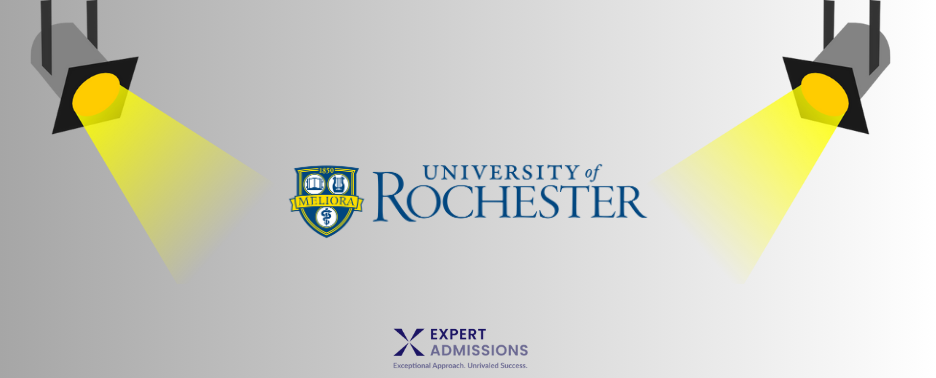
About University of Rochester
Location: Rochester, NY
Undergraduate Population: 6,764
Most Popular Majors: Business, Psychology, Computer Science, Mechanical Engineering, Economics
Motto: Meliora (“Even Better”)
Demographics:
White 38.6%
Asian/Asian American 16.9%
Latinx 8.3%
Black/African American 5.3%
Multiracial 4.2%
Native American less than 1%
History:
The University of Rochester was founded on January 31, 1850 by a convention of Baptists, alongside Madison University, which is now Colgate University. Classes began that November, with approximately 60 enrolled students, including 28 transfer students from Madison. From 1850 to 1862, the university was located at the old United States Hotel in downtown Rochester. For the next 10 years, the college continued to grow, expanding in endowment, student body, and faculty. A gift of eight acres of farmland from local businessman and Congressman Azariah Boody helped build the university’s first campus The first building on this new land, Anderson Hall, was constructed in 1862. Over the next sixty years, the Prince Street Campus grew, adding fraternity houses, dormitories, and academic buildings including Sibley Library, Eastman and Carnegie Laboratories, the Memorial Art Gallery, and the campus center, Cutler Union.
During the 1890s, a number of women took classes and labs at the university as “visitors” while not being officially enrolled. The first female students were admitted in 1900, courtesy of the efforts of famous suffragist Susan B. Anthony and Helen Barrett Montgomery. Thirty-three women enrolled among the first class in 1900, and Ella S. Wilcoxen was the first to receive a degree, in 1901. In 1955, separate colleges for men and women were merged into one university on the River Campus. In 1958, three new schools were created in engineering, business administration, and education.
In 2005, the then-President Joel Seligman announced the Meliora Challenge, a $1.2 billion capital campaign. In 2016, the university announced the Meliora Challenge had exceeded its goal, and the funds were allocated to support over 100 new endowed faculty positions and nearly 400 new scholarships. In 2021, the Sloan Performing Arts Center opened, providing space for theatrical programs, dance programs, concerts, and other activities, and serves as a home for the Institute for the Performing Arts.
Today, the University of Rochester offers more than 160 undergraduate academic programs across the humanities, natural sciences, social sciences, and engineering.
Notable University of Rochester alumni include actor Lance Reddick, Nobel-prize winning physicist Steven Chu, young adult fiction author Jennifer Donnelly, aerospace engineer Robert Zubrin, and Broadway composer Charles Strouse.
Traditions:
- University of Rochester students engage with the local community each year on Wilson & Eastman Day. The day is dedicated to projects that give back—including painting, gardening, and delivering meals.
- During Yellowjacket Weekend, students kick off the academic year full of school spirit. Festivities start at the Activities Fair and continue into a weekend full of giveaways, competitions, carnival games, a luau dinner, and live music.
- Boar’s Head Dinner is an annual Medieval-style dinner which starts with a procession of royalty featuring student leaders and select administrators clad in themed regalia. The community enjoys performances from student organizations, a feast, a unique reading of the “Tale of the Boar,” and a sing-along.
Noteworthy Features:
- The Take Five Scholars Program allows students to spend an additional semester or year—tuition-free—exploring interests outside their major or a topic they wish to study in greater depth. The Experiential-Five (e5) Program extends the same offer but with an entrepreneurial focus. e5 students pursue internships, undertake special projects, develop entrepreneurial plans, or launch a start-up. Both programs involve a competitive application process where students propose a course schedule, an action plan, and a faculty advisor.
- 77% of Rochester students get involved in the Undergraduate Research Programs. Opportunities include Research and Innovation Grants and publication in the Journal of Undergraduate Research.
- Students selected for the Senior Scholars Program undertake a capstone project that can range from a piece of scholarly research to a work of artistic creativity.
Admissions Profile
Average GPA: 3.73
Test Scores (mid-50% range): 1410-1510 SAT / 31-34 ACT
Admit Rate: 35.8%
Test-optional? Yes
Offers Early Admissions? Yes—Early Decision I and II
Supplemental Essays
University of Rochester’s required essay prompts:
The University of Rochester benefactor, entrepreneur, photography pioneer and philanthropist George Eastman said, “The progress of the world depends almost entirely upon education.” In what ways do you envision using the curricular flexibility and co-curricular opportunities at the University of Rochester to promote progress and change within the communities you inhabit? (250 word limit)
Rochester asks you to write an essay about how you might make an impact on your on-campus communities.
First, you must conduct research on the college and what opportunities you wish to pursue there. Once you’ve conducted in-depth research, connect the school’s resources to your interests and how you’d uniquely contributel. Remember that you’re presenting a picture of yourself, and that should help admissions officers picture you on campus.
Rather than writing generic statements that could be true for any school, focus on the uniqueness of the specific community at Rochester and how specific qualities can support your interests and goals. Don’t just write about what you’re going to get out of the experience, but why it matters to you as well. How will the community help you grow? In what ways will you contribute?
Remember that specific details—about both you and Rochester’s opportunities—are key when it comes to a response that supports your application well. When writing this essay, focus on the unique relationship between you and the school.
For more tips on common supplemental essay prompts, see our blog post here.
Leave a Reply